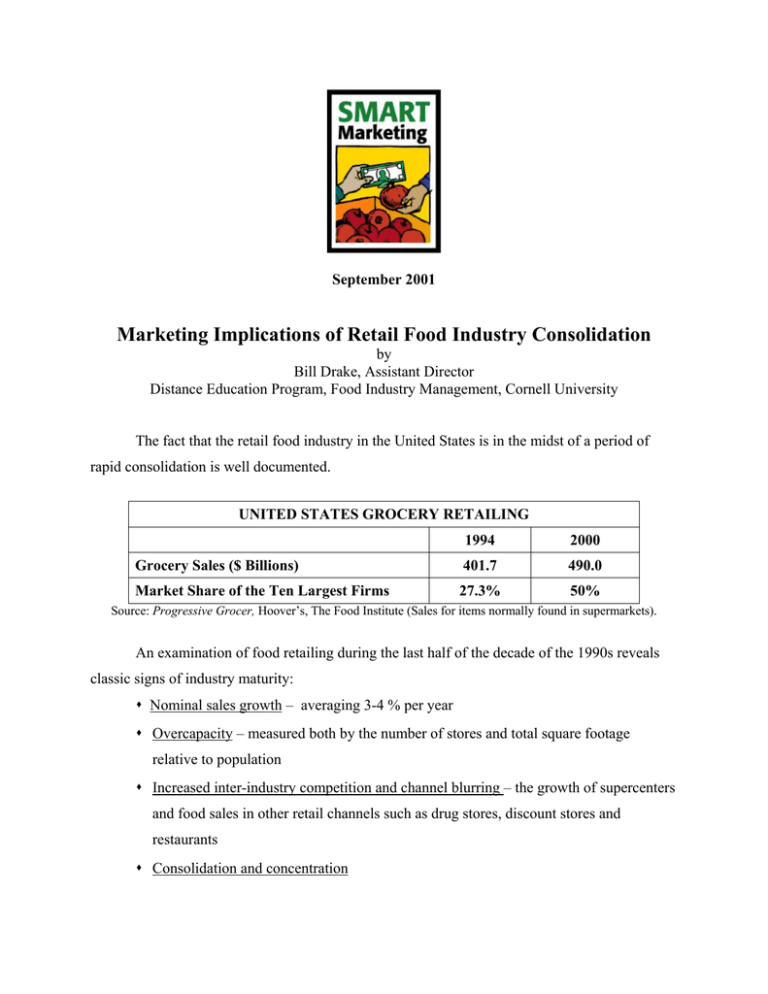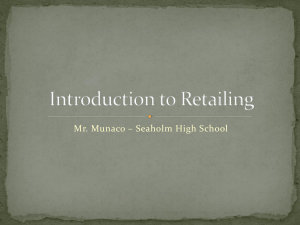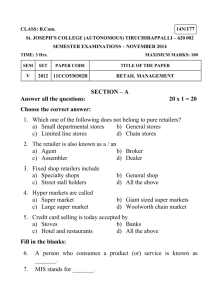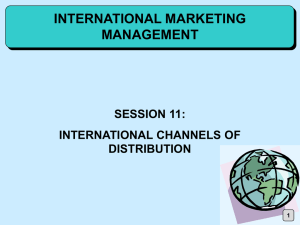Marketing Implications of Retail Food Industry Consolidation
advertisement

September 2001 Marketing Implications of Retail Food Industry Consolidation by Bill Drake, Assistant Director Distance Education Program, Food Industry Management, Cornell University The fact that the retail food industry in the United States is in the midst of a period of rapid consolidation is well documented. UNITED STATES GROCERY RETAILING 1994 2000 Grocery Sales ($ Billions) 401.7 490.0 Market Share of the Ten Largest Firms 27.3% 50% Source: Progressive Grocer, Hoover’s, The Food Institute (Sales for items normally found in supermarkets). An examination of food retailing during the last half of the decade of the 1990s reveals classic signs of industry maturity: Nominal sales growth – averaging 3-4 % per year Overcapacity – measured both by the number of stores and total square footage relative to population Increased inter-industry competition and channel blurring – the growth of supercenters and food sales in other retail channels such as drug stores, discount stores and restaurants Consolidation and concentration The recent consolidation activity, while itself a symptom of maturity, is also a response strategy on the part of the industry. Wall Street stock valuations require sales growth in excess of what can be organically produced in a saturated marketplace – the response has been significant acquisition activity on the part of the large industry players. Also driving acquisition activity has been a desire to achieve scale economics in purchasing and technology, particularly in light of the rapid growth of Wal-Mart. Finally, acquisition has been a means for large players to boost otherwise pressured profit margins via the elimination of supply chain redundancies. Independent operators, both local and regional, are in many cases responding to intense competition, increased sophistication of operations, and rising capital intensity by divesting – selling to the large industry consolidators such as Kroger, Safeway, Albertsons, and Ahold, among others. Consolidation poses many challenges to the industry. Large acquirers are pressured to effectively assimilate the acquired companies, and importantly, deliver the “promised” synergies upon which the acquisitions are predicated. Remaining smaller competitors face ever-larger more sophisticated competitors. The balance of power between retailers and manufacturers is shifting to the favor of retailers – spawning a host of new trade relation issues and behaviors. More subtle are the marketing oriented challenges posed by consolidation: “Sameness” - The large industry consolidators operate similar formats (combination stores and superstores) that share relatively common characteristics in terms of size, assortments, service levels and pricing. We are seeing a convergence of positioning strategies as the industry consolidates. This format and marketing convergence is compounded as the consolidators turn their attention inward toward acquisition assimilation, rather than outward toward the marketplace and the creation of differentiation. In contrast, the acquirees - in many cases regional or local independent operators – have historically been format innovators with very distinctive positioning strategies and identities. As formats and “go to market” strategies converge in the new environment, it will be incumbent upon the large industry player to create meaningful differentiation strategies. Retail competition based on differentiation is efficient from both the retailer and consumer perspective. In contrast, competition in an environment of sameness tends to stress industry economics, limit consumer choice, and be attritionbased. The consequence of strategies that results from consolidation will also create new opportunities for smaller players - in a marketplace of sameness, distinctiveness is a powerful strategy. Closeness to the Consumer - The past several years have witnessed the acquisition of many local and regional food retailers whose marketing strategies were largely predicated on serving the unique needs and preferences of consumers at the local level (Carr’s in Anchorage, Genuardi’s in Philadelphia, Bruno’s in Alabama, Dick’s in southwest Wisconsin, to name a few). It remains to be seen how well the large consolidators balance the need for scale economics against the preservation of these retailers’ uniquely consumer-oriented strategies. Technology based Customer Relationship Marketing (CRM) strategies that are based on linking customer identities with purchase behavior offer unique opportunities for the large consolidation to devise unique customer oriented strategies. The large retailers are only now beginning to tap the potential of these programs. Redefinition of Markets – All businesses have a tendency to define their industries and markets according to their experience, immediate surroundings and at the end of the day, “whatever suits their needs”. Food retailing has more than many industry groups exemplified this way of thinking and approach to strategy. Food retailers have historically adhered to a formula of “selling food” to the exclusion of related product lines or services. Meanwhile, food retailing has been greatly impacted by discount stores adding food and creating the Supercenter format, drug stores reaching outside their traditional channel and selling food, the creation of the warehouse club format, and the restaurant channel developing the takeout aspect of their business. Food retailing has been slow to react… but as the industry consolidates, the largest players are beginning to expand beyond the traditional industry boundaries. Many food retailers, to the dismay of the convenience store channel, are adding gasoline to their product offerings. The most innovative are diversifying into related industries where fragmentation offers significant growth opportunities via further acquisition. Ahold’s acquisitions in the food service industry are a good example. It is likely that further “inter-industry” growth on the part of traditional food retailers will occur during the next 3 – 5 years. Consolidation poses many challenges to US food retailers. While the tendency is to focus on the short-term issues spawned by acquisition activity, it is the less clear marketing issues that will define the industry for years to come. "Smart Marketing" is a monthly marketing newsletter for extension publication in local newsletters and in local media. It reviews the elements critical to successful marketing in the food and agricultural industry. Articles are written by faculty members in the Department of Applied Economics and Management at Cornell University "Share the gift of communication." Please cite or acknowledge when using this material.







